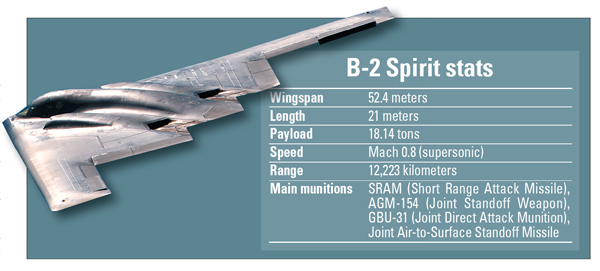U.S. conducts B-2 stealth bomber drill over Korea

The U.S. Strategic Command sent two B-2 Spirit Bombers from Whiteman Air Force Base in Missouri for a round-trip training mission, flying more than 6,500 miles to Korea, as part of the two-month Foal Eagle military exercises, which began March 1.
These multirole heavy bombers dropped dummy munitions on their drill targets on an island bombing range off the west coast of Korea and returned to the U.S. during a single, long-duration mission, the South-U.S. Combined Forces Command stated in a release yesterday.
The joint command said the mission “demonstrates the United States’ ability to conduct long-range, precision strikes quickly and at will” and is a display of “the commitment of the U.S. and its capability to defend the Republic of Korea.”
This follows Pyongyang’s heightened threat after its third nuclear test in February against Washington, stating that Guam, Hawaii and even the U.S. mainland were strike targets.
The 72.5-ton two-pilot bomber is known for its stealth technology, including a radar absorbent surface, which enables it to penetrate the enemy’s defense. They can strike long-range targets with precision.
“The B-2 bomber is an important element in America’s enduring and robust extended deterrence capability in the Asia-Pacific region,” added the joint command. “Holding the B-2 bomber drill in Korea is a display of the U.S.’ pledge and capability to defend the South,” said a South Korean defense official, “in keeping with its promise to continuously defend Korea against invasion as an allied country.”
This is following two tests of the nuclear-capable, long-range strategic B-52 bombers earlier this month.
The U.S. also previously unveiled nuclear capable B-22 bombers and attack submarine USS Cheyenne in the past month.
The Pentagon stated yesterday that U.S. Defense Secretary Chuck Hagel in a phone conversation with his Korean counterpart, Minister of National Defense Kim Kwan-jin, affirmed “the steadfast U.S. commitment to the defense of South Korea” and “pointed to the recently signed the ROK-U.S. counter-provocation plan as a mechanism to enhance consultation and coordination of alliance responses to North Korean aggression.”
Hagel emphasized that a nuclear umbrella would be extended to the South.
Last Friday, the Joint Chiefs of Staff signed the Combined Counter-Provocation Plan, a Korea-led contingency plan supported by the U.S. “designed to counter future North Korean provocations.”
By Sarah Kim [sarahkim@joongang.co.kr]










with the Korea JoongAng Daily
To write comments, please log in to one of the accounts.
Standards Board Policy (0/250자)